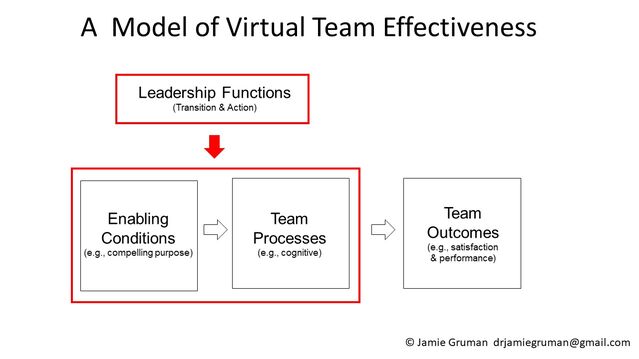Leadership
How to Lead Virtual Teams
A simple model can help you build and manage effective virtual teams.
Posted September 26, 2020

With more and more teams working virtually these days, managers are looking for ways to ensure that their physically distant teams operate well and produce both employee satisfaction and productive output. This is increasingly important given the challenges associated with virtual teams. Research has shown that paying attention to a few features associated with building and managing teams and virtual teams can be highly effective at producing both happy employees and effective performance.
First, leading teams effectively requires the implementation of specific leadership functions in order to ensure that the needs of the team are met. Not surprisingly, this is called the functional approach to team leadership and it includes two sets of functions. Transition Phase Functions involve planning for team success and include things such as selecting appropriate team members, clarifying roles and responsibilities, and providing adequate training and development. Action Phase Functions involve getting the actual work done and handling the challenges that invariably arise. Functions within this phase include things such as monitoring team progress, solving problems, and fostering a supportive team climate. These leadership functions are required regardless of whether teams are externally managed or self-managed.
Team leadership functions help to establish the enabling conditions that teams guru Richard Hackman argues allow teams to succeed. Such conditions create a context that supports natural team processes that foster desired outcomes and require less direct management intervention. The enabling conditions include building a team that has collective accountability and is not a team in name only, having a compelling purpose that energizes team members, and establishing clear norms of conduct that specify which team behaviors are expected and which are not acceptable.
When the right functions and conditions exist, teams are more likely to display the processes that promote team success. These processes are the mechanisms through which desired outcomes are produced. Team cognitive processes involve having a shared mental model—a common understanding of expected behavior—that allows team members to coordinate their actions. Efforts to create a shared mental model, or shared mindset, among team members is particularly important in physically distributed teams in order to prevent an “us vs them” mindset and a failure to share information.
Team motivational processes, which motivate team members to invest effort, derive in part from the team’s collective efficacy—its belief in its ability to perform well. Team affective processes are reflected in the emotional tone of the team which can help or hinder cooperation, cohesion, and influence the prevalence and nature of conflict. Finally, team coordination processes reflect how well team members synchronize their work and behavior.
These individual components can be integrated into a model of effective virtual team functioning. As noted in the model below, leadership functions serve as a basis for the development of the enabling conditions that lead to team processes that generate outcomes such as performance and satisfaction.
The leadership functions also serve to support team processes directly by, for example, making it pleasant to be on the team in order to promote team affective processes. Managers looking for a way to think about the effective management of virtual teams can use this model as a diagnostic tool to assess how to build effective virtual teams and also to diagnose the source of problems when virtual teams are not performing as expected.

As work moves online and virtual teams become more popular, it is increasingly important for managers to know how to help teams operate well in the absence of physical contact. Recognizing the value of team functions, enabling conditions, and processes is an important step in understanding how to lead virtual teams well and help them manage themselves effectively.


